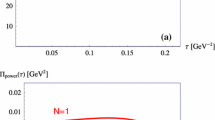Summary
A theory of mesons is based on the experimentally observed linear level spacing of hadron excitations. The theory uses a model for the internal structure of mesons consisting of a system of harmonic vibrations. Roughly speaking, a meson is described by the degrees of freedom of a four-dimensional rubber band with a quark pair embedded in it. The theory satisfies relativistic invariance, crossing symmetry and a generalization of duality which we call dual-symmetry. In the approximation of retaining only tree graphs, the scattering amplitudes are given by then-point dual amplitudes recently proposed by Virasoro, Bardakci and Ruegg, Chan and Goebel and Sakita. In the special case,n=4, we reproduce Veneziano’s formula.
Riassunto
Si basa una teoria mesonica sul distanziamento lineare dei livelli osservato sperimentalmente. La teoria usa un modello per la struttura interna dei mesoni consistente di un sistema di vibrazioni armoniche. Parlando in generale, si descrive un mesone con i gradi di libertà di una striscia di gomma a quattro dimensioni che porta incastonata una coppia di quark. La teoria soddisfa l’invariauza relativistica, la simmetria incrociata ed una generalizzazione della dualità che è chiamata simmetria duale. Facendo l’approssimazione di conservare solo tre grafici, si esprimono le ampiezze di scattering con le ampiezze duali conn punti proposte recentemente da Virasoro, Bardakci e Ruegg, da Chan e Goebel e da Sakita. Nel caso specialen=4 si riottiene la formula di Veneziano.
Резюме
Теория мезона основывается на экспериментально наблюдаемом линейном интервале между уровнями для адронных возбуждений. Эта теория использует модель для внутренней структуры мезонов, состоящую из системы гармонических колебаний. Грубо говоря, мезон описывается степенями свободы для четырехмерного «резинового слоя» с внедренной в него парой кварков. Рассматриваемая теория удовлетворяет релятивистской инвариантности, кроссинг-симметрии и обобщению дуальности, которое мы называем дуальной симметрией. В приближении, сохраняющем лишь древовидные графики, вьшисываются амплитуды рассеяния черезn-точечные дуальные амплитуды, недавно предложенные Вирасоро, Вардакчи и Руеггом, Ченом и Гоебелом и Сакита. В частном случаеn=4 мы воспроизводим формулу Венециано.
Similar content being viewed by others
References
M. Ademollo, H. R. Rubinstein, G. Veneziano andM. A. Virasoro:Phys. Rev. Lett.,19, 1402 (1967);Phys. Lett.,27 B, 99 (1968);G. Veneziano:Nuovo Cimento,57, 190 (1968);M. A. Virasoro:Phys. Rev. Lett.,22, 37 (1969);K. Bardakci andH. Ruegg:Phys. Lett.,28 B, 342 (1968);H. M. Chan:Phys. Lett.,28 B, 425 (1969);C. Goebel andB. Sakita:Phys. Rev. Lett.,22, 257 (1969).
K. Kikkawa, B. Sakita andM. A. Virasoro:Feynman-like diagrams compatible with duality, University of Wisconsin preprint COO-224 (1969);K. Bardakci, M. Halpern andJ. Shapiro: University of California preprint;G. Frye andL. Susskind:Feynman diagrams and duality, Yeshiva University preprint.
This model was first put forward by the author inL. Susskind:Physical interpretation of duality, Yeshiva University preprint. The formal manipulations in the model were independently discovered slightly earlier byY. Nambu: University of Chicago preprint;S. Fubini, P. Gordon andG. Veneziano:Phys. Lett., and the author, Yeshiva University preprint,Structures of hadrons implied by duality.
H. Harari:Phys. Rev. Lett.,22, 689 (1969);J. L. Rosner:Phys. Rev. Lett.,22, 689 (1969).
R. J. Glauber:Phys. Rev.,231, 2766 (1963).
By normal ordered function we mean a power series in thea + anda − in which each term has all thea + factors to the left of thea − factors.
Calculations in which quanta can interact with both quarks in the same process were reported byJ. C. Gallardo, E. Galli andL. Susskind: Yeshiva University preprint,Structure of hadrons, II.
The parameter τ was used byFeynman to define relativistic path integrals for bosons:R. P. Feynman:Phys. Rev.,80, 440 (1950) (see Appendix A). The parameter τ is also discussed inL. Susskind:Phys. Rev. Lett.,24, 944 (1968).
L. Susskind:Phys. Rev. Lett.,23, 545 (1969).
The relations between channels, cycles and Mandelstam invariants were discussed byG. Frye andL. Susskind, see ref. (2)Feynman diagrams and duality, Yeshiva University preprint.
R. F. Streater andA. S. Wightman PCR, Spin and Statistics and All That (New York, 1964).
H. B. Nielsen: Nordita preprint.
G. Frye:Dual symmetric harmonic-oscillator model of hadrons for arbitrary ground-state mass, Yeshiva University preprint.
Author information
Authors and Affiliations
Additional information
Supported in part by A.F.O.S.R. Grant No. 1282-67.
Traduzione a cura della Redazione.
Перебедено редакцией.
Rights and permissions
About this article
Cite this article
Susskind, L. Dual-symmetric theory of hadrons.—I. Nuovo Cimento A (1965-1970) 69, 457–496 (1970). https://doi.org/10.1007/BF02726485
Received:
Published:
Issue Date:
DOI: https://doi.org/10.1007/BF02726485



